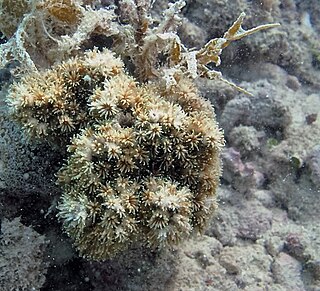Related Research Articles

The crab-eating macaque, also known as the long-tailed macaque and referred to as the cynomolgus monkey in laboratories, is a cercopithecine primate native to Southeast Asia. A species of macaque, the crab-eating macaque has a long history alongside humans. The species has been alternately seen as an agricultural pest, a sacred animal, and, more recently, the subject of medical experiments.
The Aurantimonadaceae are a small family of marine bacteria.

The bicolor angelfish is a marine species of fish, easily recognizable by its yellow tail, yellow front half of their body, and blue rear with blue patterns above and around the eye. Other names of this angelfish include: Pacific rock beauty, oriole angelfish, oriole dwarf angel, blue and gold angel, and two-colored angel. The life expectancy in the wild varies greatly, depending on location, and ranges between 5 and 13 years. These fish tend to grow to a maximum of 6 inches in length. The larval stages lasts approximately 32 days.
The Flammeovirgaceae are a family of bacteria.

Acicular, in mineralogy, refers to a crystal habit composed of slender, needle-like crystals. Crystals with this habit tend to be fragile. Complete, undamaged acicular specimens are uncommon.

Nephtheis fascicularis, commonly called the lollipop tunicate, lollipop coral, or blue palm coral, is a species of tunicate that is native to the shallow reefs of Indonesia. It is the only species in its genus Nephtheis. They are not photosynthetic, and live on plankton and small organic particles obtained from the water currents. The branched stems are formed by tiny polyps called zooids.
Actinophytocola is a genus in the phylum Actinomycetota (Bacteria).

Galaxea is a genus of colonial stony corals in the family Euphylliidae. Common names include crystal, galaxy, starburst and tooth coral. They are abundant on reefs in the Indo-Pacific region and the Red Sea. They are found in water less than 20 metres (66 ft) deep and favour turbid sites. They are sometimes kept in reef aquaria.

Galaxea fascicularis is a species of colonial stony coral in the family Euphylliidae, commonly known as octopus coral, fluorescence grass coral, galaxy coral among various vernacular names.
Rhytidocystis is a genus of apicomplexans.
Vitrella brassicaformis (CCMP3155) is a unicellular alga belonging to the eukaryotic supergroup Alveolata. V. brassicaformis and its closest known relative, Chromera velia, are the only two currently described members of the phylum Chromerida, which in turn constitutes part of the taxonomically unranked group Colpodellida. Chromerida is phylogenetically closely related to the phylum Apicomplexa, which includes Plasmodium, the agent of malaria. Notably, both V. brassicaformis and C. velia are photosynthetic, each containing a complex secondary plastid. This characteristic defined the discovery of these so-called 'chromerids,' as their photosynthetic capacity positioned them to shed light upon the evolution of Apicomplexa's non-photosynthetic parasitism. Both genera lack chlorophyll b or c; these absences link the two taxonomically, as algae bearing only chlorophyll a are rare amid the biodiversity of life. Despite their similarities, V. brassicaformis differs significantly from C. velia in morphology, lifecycle, and accessory photosynthetic pigmentation. V. brassicaformis is green, with a complex lifecycle involving multiple pathways and a range of sizes and morphologies, while Chromera is brown and cycles through a simpler process from generation to generation.
Aurantimonas coralicida is a gram-negative bacterium, and a causative agent of white plague in Caribbean corals. It is rod-shaped, with polar flagella.
Aeromonas simiae is a Gram-negative, oxidase- and catalase-positive motile bacterium of the genus Aeromonas, with a polar flagellum, isolated from the faeces of a healthy monkey.
Prauserella coralliicola is a Gram-positive bacterium from the genus Prauserella which has been isolated from the coral Galaxea fascicularis from the Luhuitou fringing reef in China.

Bulbanaricus davaoensis is a marine fish of the family Syngnathidae. It is found in the western Indian Ocean, the western Pacific Ocean from the Philippines to Fiji, and from Japan to the Great Barrier Reef, in Australia. Planktonic juveniles are found in the upper 200m of 610-7120m deep waters. The adult stage of this species is found among coral reefs to depths of 8m, and can grow to lengths of 4.3 cm. It is ovoviviparous, with the males carrying eggs in brood pouches until they are ready to hatch. It is a small secretive species which prefers to live among the galaxy coral Galaxea fascicularis.

Galaxea acrhelia is a large polyp stony coral in the family Euphylliidae.

Ricordea yuma is a species of coral in the family Ricordeidae, order Corallimorpharia; This order of corals do not produce the distinctive calcification of the closely related Scleractinian, or reef building corals. Ricordea yuma are found on the sea floor in relatively shallow, tropical or subtropical ocean environments. Distinctive features include a large mouth disk that takes up most of the organism, and brightly colored tentacles. Ricordea yuma can reproduce both sexually, and asexually by budding a new coral with replicated elements from the mother coral. This may be one mechanism of how they are able to spread and overtake areas rapidly; They have been observed being competitively successful at monopolizing areas by excluding reef-building coral species, after a disturbance in the substrate.
Endozoicomonas is a genus of Gram-negative, aerobic or facultatively anaerobic, chemoorganotrophic, rod-shaped, marine bacteria from the family of Hahellaceae. Endozoicomonas are symbionts of marine animals.
Aureisphaera salina is a Gram-negative, aerobic, chemoheterotrophic, rod-shaped and non-motile bacterium from the genus of Aureisphaera which has been isolated from an ascidian from the Kohama Island.
References
- 1 2 "Species: Aureisphaera galaxeae". lpsn.dsmz.de.
- 1 2 Yoon, Jaewoo; Yasumoto-Hirose, Mina; Kasai, Hiroaki (June 2015). "Aureisphaera galaxeae gen. nov., sp. nov., a marine member of the family Flavobacteriaceae isolated from the hard coral Galaxea fascicularis". Antonie van Leeuwenhoek. 107 (6): 1379–1386. doi:10.1007/s10482-015-0432-4.